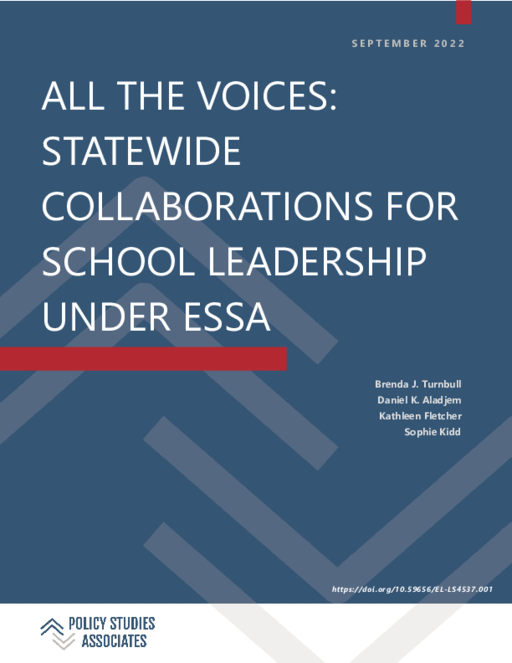Breadcrumb
- Wallace
- Reports
- All The Voices Statewide Collabo...
All the Voices
Statewide Collaborations for School Leadership under ESSA

- Author(s)
- Brenda J. Turnbull, Daniel K. Aladjem, Kathleen Fletcher, and Sophie Kidd
- Publisher(s)
- Policy Studies Associates, Inc.
Summary
How we did this
Researchers from Policy Studies Associates documented each team meeting of the ESSA Leadership Learning Community. They also conducted interviews and focus groups with team members.
In late 2015, the main federal law for financing K-12 education was reauthorized with a twist. The Every Student Succeeds Act gave states new authority over their use of federal funds.
This raised a question. Could the revised law help states foster effective and equity-minded school principals? The Wallace Foundation with three partners set up a novel effort based on that question. The five-year venture (2016-2022) resulted in innovative programs and policies.
The endeavor was called the ESSA Leadership Learning Community, or ELLC. It was unusual because of its composition. At its heart were teams of people with a vital stake in public school education. Yet they had rarely engaged with one another for sustained conversation about how to improve it. ELLC teams comprised state education officials, leaders of selected school district leaders, and community representatives. There were 11 such teams from 11 states. This report shares results of their work together and lessons learned.
Results
The report places the teams’ work into four categories:
- Advice to state agencies on ESSA planning and roll-out. For example, ideas from the Missouri team about equity indicators became part of the state’s ESSA-related work.
- New or improved professional learning programs for principals. The Nebraska team inspired and contributed to a principal preparation program to serve non-urban school districts.
- Contributions to the design of school leadership programs. The New York team recommended ways to prepare principal candidates who could work effectively with diverse student populations.
- New resources for the field. The Tennessee and Minnesota teams developed guides for equity-minded leadership. These are aimed at districts, schools, families, and others.
A variety of other products and policy ideas across these four categories came from all 11 state teams.
Lessons
The authors drew lessons for future cross-sector collaborations. Among them:
- The most innovative aspect of the ELLC was its diversity of voices. Many teams developed norms of listening to community members. They didn’t automatically defer to the authority of the state agency. The authors describe the creative thinking that this promoted even though discussion became fraught at times.
- Relationships between individuals and organizations drove the work. Providing time and space for relationships to develop was crucial. Many organizations at the table had historically clashed.
- Teams had freedom to define their goals within certain guidelines. Some struggled at first to find a direction. But most participants agreed that the effort was worthwhile. The work teams selected met the needs and consensus of the group.
Wallace’s ELLC partners were:
- The Council of Chief State School Officers
- The Council of the Great City Schools
- The National Urban League
ELLC members were:
- Teams from Florida, Maryland, Minnesota, Missouri, Nebraska, New York, Ohio, Oregon, Pennsylvania, Tennessee, and Wisconsin
- Selected urban and rural school districts in those states
- Community members, including those from community organizations, local or statewide non-profits, regional service agencies, statewide associations, and universities.

Our evidence suggests that a key driver of team success has been the relationships team members have built, both organizational and interpersonal.

